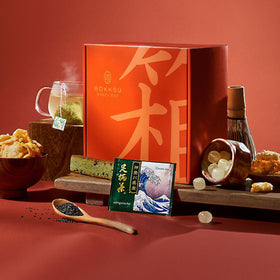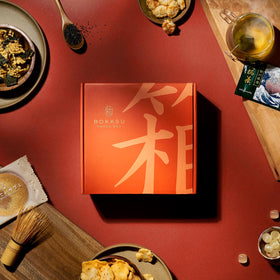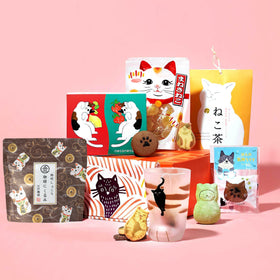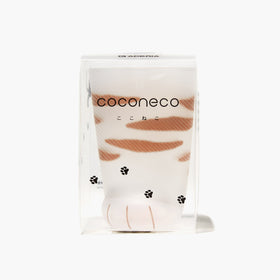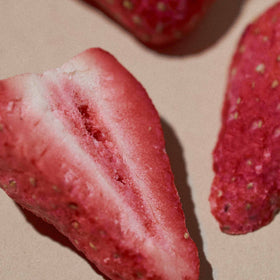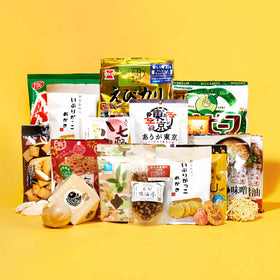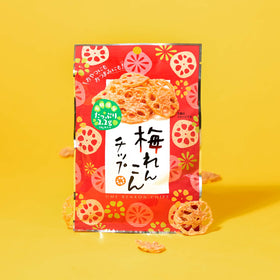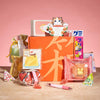Handmade Elegance: Premium Japanese Pottery Gifts
Pottery as a Cultural Gift in Japan

Pottery has long been one of Japan's most enduring and meaningful cultural gifts, valued not just for its beauty but for its role in hospitality, tea ceremonies, and as a timeless way to show appreciation. Unlike Chinese ceramics, which often feature bright colors, intricate patterns, and glossy porcelain glazes, Japanese ceramics embraces earthy tones, rustic textures, and the wabi-sabi philosophy—finding beauty in simplicity and imperfection. Made from mineral-rich clays, these pieces are often heavier and more grounded, and built to last for generations.
In Japan, ceramics are further celebrated through the recognition of “Living National Treasures”—master artisans who dedicate their lives to preserving and advancing pottery techniques, passing their knowledge to apprentices to ensure these traditions endure. A handcrafted bowl, tea cup, or sake set is never just an object; it carries centuries of artistry, philosophy, and care, making Japanese pottery a timeless cultural gift treasured by tea practitioners, hosts, and collectors alike.
Mashiko Yaki: Rustic Charm for Everyday Use

Mashiko ceramics, originating from the pottery town of Mashiko in Tochigi Prefecture, hold a special place in the modern history of Japanese pottery and are prized for their earthy tones, hand-thrown forms, and timeless rustic charm. Made from the region’s coarse, sandy clay, which requires careful processing, Mashiko ware translates beautifully into practical earthenware for casual dining or rustic home décor. Its signature “persimmon” (kaki-aka) glaze, derived from iron-rich Ashinuma stone, develops a warm reddish-brown finish during firing, often paired with deep black glazes for striking contrast. While Mashiko once mass-produced simple jars, pots, and plates in the late 19th and early 20th centuries to meet everyday needs, it later became a global center for artisan pottery thanks to Shoji Hamada, who established a studio there in the early 1900s and elevated the town through the Mingei folk craft movement. Recognized as the first Living National Treasure in a craft-related field, Hamada’s influence continues to shape Mashiko’s hand-thrown ceramics, offering a perfect blend of tradition, artistry, and functionality for pottery lovers worldwide.
Shigaraki Ware Gifts: Centuries of Kiln Tradition

Shigaraki, in Shiga Prefecture, is renowned for its Shigaraki ware (Shigaraki yaki) and stands as one of Japan’s six historic pottery regions. With a ceramic tradition stretching back over 800 years to the late 13th century, it represents one of the oldest styles of ceramic production in the country. Shigaraki is celebrated for its high-quality clay, prized for its warm, natural textures and fire resistance—perfect for tea utensils as well as large storage jars. The firing process brings out soft, skin-toned hues, gentle pinks, and reddish-browns, often accented with subtle natural glazes that reflect the wabi-sabi philosophy of simplicity and imperfection. Shigaraki is also famous for its tanuki figurines, commonly seen outside izakaya and shops, believed to invite good fortune and prosperity.
Today, visitors can experience Shigaraki’s rich ceramic legacy firsthand at the Shigaraki Ceramic Cultural Park, where historic works are on display, hands-on pottery workshops welcome the public, and annual markets give artists a chance to showcase and sell their creations. With Shigaraki Station as its gateway, this kiln town continues to thrive as a vibrant center of tradition, artistry, and everyday beauty.
Other Famous Kiln Towns: Legends Beyond the Big Names

Japan’s pottery towns each tell a story of history, culture, and artistry, with regional specialties that make their ceramics highly prized both at home and abroad. In western Japan, Arita in Saga Prefecture is celebrated as the birthplace of Japanese porcelain, where potters first discovered kaolin clay in the early 17th century. The ceramics produced here—known as Arita ware—are thin, durable, and translucent, often adorned with intricate designs in vibrant blues, reds, and golds, as well as the classic blue-and-white porcelain that came to symbolize elegance. During the Edo period, the Dutch East India Company exported vast amounts of Arita porcelain to Europe, where it was treasured by royalty and collectors alike. From this tradition also emerged Nabeshima ware, a refined porcelain once made exclusively for the ruling class, admired for its exceptional quality and sophisticated painted motifs. These ancient kilns helped cement Japan’s global reputation for porcelain, making Arita one of the country’s most iconic pottery towns.
Other kiln towns developed their own distinct styles, shaped by local resources and cultural influences. Seto in Aichi Prefecture, home to many kilns, became known for experimenting with glazes inspired by Chinese ceramics, such as green celadon and deep brown tenmoku, eventually evolving into glossy, iron-rich finishes that gave Seto ware its signature look. In Ishikawa Prefecture, Kutani ware captivated the world with its bold, colorful style—known as Kutani gosai—featuring striking reds, yellows, greens, purples, and blues. Its international debut at the 1873 World Exposition cemented its reputation as one of Japan’s most recognizable pottery traditions. Meanwhile, Kyoto gave rise to Raku ware, hand-molded earthenware created for the tea ceremony in the 16th century, embodying the Zen ideals of simplicity and imperfection. Together, these pottery towns showcase how different regions nurtured unique ceramic traditions, each with its own history, firing techniques, and glaze aesthetics, making them perfect destinations for discovering Japan-exclusive ceramics.
The Appeal of Japanese Porcelain and Handmade Tableware

In Japan, handmade tableware has grown in popularity as people seek pieces that are not just functional but also full of personality and artistry. Bowls, plates, and cups shaped by skilled hands carry a warmth and character that mass-produced items simply can’t match. This individuality creates a connection to centuries of tradition, echoing the care that tea masters once put into selecting tea bowls and tea utensils for the tea ceremony. Today, the same philosophy carries into modern dining, where handmade tableware is valued both as functional art and as a thoughtful, personal gift—pieces that elevate meals while reflecting the craftsmanship behind them.
Bokksu Boutique celebrates this tradition with Japanese ceramics that combine timeless design with modern living. The Hasami Ware Painted Peach Bowl, a hand-painted Gorohachi Chawan inspired by the Edo period, is perfect for serving soup, vegetables, or dessert. The Saga Hasami Yaki Mug Cup, crafted from Amakusa pottery stone in Nagasaki, adds everyday elegance and durability to your table, while the Minoyaki Kozara Small Plate – Saffron features a chrysanthemum motif for good fortune and a rustic glaze that makes each piece one-of-a-kind. Together, these ceramics showcase the beauty and practicality of handmade tableware, making them thoughtful gifts for any occasion.
Pottery in Japanese Gifting Etiquette

In Japan, pottery occupies a special place in gifting etiquette, celebrated for its blend of artistry and practicality. Finely crafted bowls, plates, or tea utensils are traditionally given at weddings, anniversaries, and housewarmings, symbolizing both beauty and everyday use. Each piece carries the warmth of local craftsmanship, making every gift unique to the region it comes from. Giving pottery today is more than just offering an object—it’s sharing a piece of culture, a touch of tradition, and a tangible connection between giver and recipient, turning every meal and moment into something memorable.
Exclusive Japanese Ceramics for Collectors

For collectors, the appeal of Japan-exclusive ceramics lies in their limited runs, regional designs, and the rich history each piece carries. Many pottery towns produce styles that reflect local traditions and resources, making them rare outside Japan and highly prized as gifts. Bokksu Boutique offers a window into this world with items like the Mino Ware Mt. Fuji Plate, featuring Hokusai’s iconic Thirty-Six Views of Mount Fuji and making a bold statement for display or dining; the Okinawa Kariyushi Ceramic Plate Set, adorned with the traditional Kariyushi pattern symbolizing happiness, perfect for serving condiments or small sides; and the Frustum Tea Set, handmade in Gifu by Yamatsu, which reimagines classic teaware with modern geometric lines while honoring the centuries-old Mino ware tradition. Each piece reflects the exclusivity, artistry, and cultural depth that make Japanese ceramics so treasured by collectors around the world.
The Balance of Tradition and Modernity in Pottery

One of the most fascinating aspects of Japanese pottery today is the way modern artisans strike a balance between tradition and innovation, creating pieces that feel at home in both a tea ceremony and a modern dining room. By combining age-old techniques with contemporary pieces featuring bold colors, geometric forms, and inventive motifs, they breathe new life into an ancient craft. The result is a new generation of fusion ceramic gifts that respect heritage while embracing fresh aesthetics. These works not only preserve the spirit of traditional pottery but also keep it relevant, making them perfect for contemporary homes without losing their timeless Japanese soul.
Bokksu Boutique: Curating Premium Pottery Gifts

For those who love Japanese pottery but can’t make the trip to historic kiln towns, Bokksu Boutique offers a carefully curated collection of artisan pieces that bring the spirit of traditional craft right to your home. Each item is chosen to highlight the balance of function, artistry, and cultural meaning that makes Japanese ceramics so special. The Haku Matcha Bowl, with its shifting coral and azure hues, captures the unpredictability of kiln-fired art and the wabi-sabi beauty of imperfection, while the Minoyaki Ocean Blue Matcha Bowl evokes the depth and calm of the sea, elevating everyday tea rituals. With pieces like these, Bokksu Boutique makes it easy to give or collect authentic Japanese artisan pottery without ever leaving home.
Legends in Clay: Sharing Japan’s Heritage Through Gifting

Japanese pottery is more than just beautiful tableware—it is a gift that carries heritage, artistry, and the timeless essence of Japanese culture. From the rustic charm of kiln towns to the refined elegance of modern designs, each piece reflects centuries of craftsmanship while offering something deeply personal and lasting. Whether chosen for a wedding, a housewarming, or simply to show appreciation, pottery embodies thoughtfulness in a way few gifts can. For those who want to share this tradition without traveling across Japan, Bokksu Boutique offers a beautifully curated collection of artisan ceramics that capture the spirit of Japanese culture. Explore our collections and discover how these handcrafted treasures can bring both beauty and meaning into everyday life.
Author Bio




